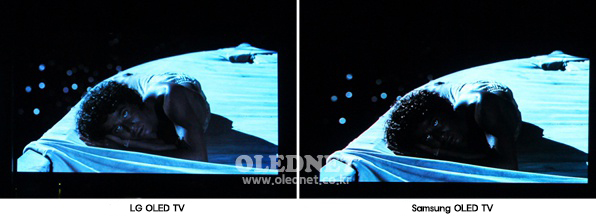Korea research organization UBI Research compares archrival LG Electronics and Samsung 55-inch OLED TVs in its latest research report. Below is the research organization’s press release.
As LG Electronics Inc. and Samsung Electronics Co., Ltd has released the same 55” curved OLED TV, products and technologies expected to lead TV markets draw attention within the industrial world and academic world.
LG’s product consists of four pixel WRGB able to show color through color filter with white OLED light while Samsung’s product realizes colors independently, producing RGB pixel respectively.
UBI Research has published a report to analyze picture quality of both companies’ 55” curved OLED TV and the report is expected forecast the direction of OLED TV products and technologies further. According to the report, the picture quality of OLED TV were analyzed with three different ways: picture quality characteristics based on panel construction, picture quality characteristics according to panel and image processing technology, picture quality characteristics according to image processing. Subcategories were evaluated with 16 features such as contrast ratio, color volume, vies angle, brightness and color temperature for display quality and image quality, and power consumption.
As OLED TV is different from LCD, the primary element to represent high quality display is how to express black color. Both products showed more than 100,000:1 contrast ratio which surpasses the limit of determination by measuring equipment. When it comes to external light (living room lightning: 200lx), LG’s curved OLED TV indicated 254 contrast ratio(ambient contrast ratio) and Samsung’s product showed 130 half numerical value of LG’s TV.
 |
|
Comparison between LG(left) and Samsung OLED TV (right) display of dark colors. (LEDinside/ UBI Research) |
Curved OLED TV might display color changes due to bent side of the TV, color volume is significant according to viewing angle. Samsung’s product showed an excellent viewing angle for white and LG’s products was outstanding for red and blue. In the light of front side, Samsung’s product showed higher color volume feature while LG’s products was superior to Samsung’s TV for color volume according to viewing angle.
The reason Samsung’s curved OLED TV has lower viewing angle, color volume and ambient contrast then LG’s TV is assumed due to straight light by micro cavity applied to improve brightness of OLED TV panel and reflexibility of WAD film to reduce the straight light.
Samsung focused on sharpness for image expression of the TV, which showed great visibility of objects and LG concentrated on the ability to express black color, showing outstanding ability to divide low tone wedge section.
Even though Samsung’s product showed excellent brightness and definition, low picture quality was displayed due to excessive gamma correction to improve brightness with middle tone wedge level.
LG’s OLED TV was analyzed it is able to express an original image produced by producer of the contents with excellent tone wedge continuity.
The report is expected to be used a guideline for companies, research institutions and academic world when it comes to OLED panel industry.












